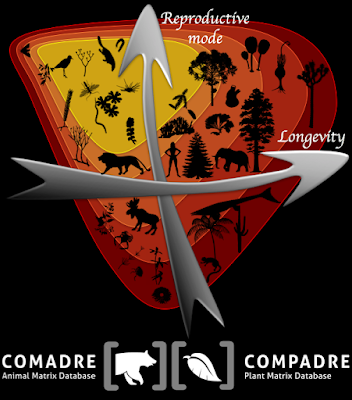Biosciences Seminar Series - Autumn 2016
17 November 2016 - 1pm - Zoology Museum (Wallace 129)
Our speaker of this week, Dr Roberto Salguero-Gómez from the Department of Animal and Plant Sciences at the University of Sheffield, will present his research on the drivers of differences in life history traits across plants and animals. Rob's research is wide-ranging, comprising animal and plant demography, including novel research on senescence (see here), drivers of variation in life history traits, causes of animal and plant performance, or effects of climate change on native biota.
In addition to his association with Sheffield, Rob is also associated with the Australian Research Council Centre of Excellence for Environmental Decisions at the University of Queensland, Australia, the Evolutionary Biodemography Laboratory at the Max Planck Institute for Demographic Research in Rostock, Germany, and the School of Natural Sciences at the Department of Zoology & Trinity Centre for Biodiversity Research at Trinity College Dublin, Ireland. Hence, this week's seminar at Swansea is a rare occasion to meet and chat to Rob in person somewhere else from an airport or a seat on a transcontinental flight :-)
In addition to his association with Sheffield, Rob is also associated with the Australian Research Council Centre of Excellence for Environmental Decisions at the University of Queensland, Australia, the Evolutionary Biodemography Laboratory at the Max Planck Institute for Demographic Research in Rostock, Germany, and the School of Natural Sciences at the Department of Zoology & Trinity Centre for Biodiversity Research at Trinity College Dublin, Ireland. Hence, this week's seminar at Swansea is a rare occasion to meet and chat to Rob in person somewhere else from an airport or a seat on a transcontinental flight :-)
Life history traits are the events in our lives that control our demographic performance, our well-being and the well-being of societies. Examples include the age at maturity, reproductive window, mean and maximum longevity, post-reproductive lifespan, number of babies produced, and mortality rate, to mention a few. These factors, which are rather well understood and known to influence human population dynamics, our economics, insurance plans, and retirement funds, to mention a few, are not unique to Homo sapiens. Life history traits can be calculated for any population from any species where the individual can be clearly defined and where demographic information is available. The great potential for application of the tools that allow for the calculation of life history traits from a rich repertoire of organisms, from orchids to ferns to redwoods, to mice, bats, bears and C. elegans would allow evolutionary ecologists to tap into questions of global scope such as what strategies are most successful in what environments, what are the factors enhancing the diversification of life history strategies, and which one restrain them.

Up until recently comparative studies examining variation in life history traits had been limited mostly to mammals and birds, mostly due to the lack of comprehensive repositories for other taxonomic groups. Here, I introduce the COMPADRE Plant Matrix Database and the COMADRE Animal Matrix Database (www.compadre-db.org), which together contain high-resolution demographic data in the shape of matrix population models for over 2,500 animal and plant species around the globe. I use the demographic machinery developed in the last years to decompose biologically meaningful life history traits from these matrices to examine what are the phylogenetic and environmental factors driving the diversity in life history strategies across plants and animals.

Up until recently comparative studies examining variation in life history traits had been limited mostly to mammals and birds, mostly due to the lack of comprehensive repositories for other taxonomic groups. Here, I introduce the COMPADRE Plant Matrix Database and the COMADRE Animal Matrix Database (www.compadre-db.org), which together contain high-resolution demographic data in the shape of matrix population models for over 2,500 animal and plant species around the globe. I use the demographic machinery developed in the last years to decompose biologically meaningful life history traits from these matrices to examine what are the phylogenetic and environmental factors driving the diversity in life history strategies across plants and animals.
Hope to see many of you - everyone most welcome to attend!
For the list of forthcoming seminars this term, see here.
For the list of forthcoming seminars this term, see here.

No comments:
Post a Comment